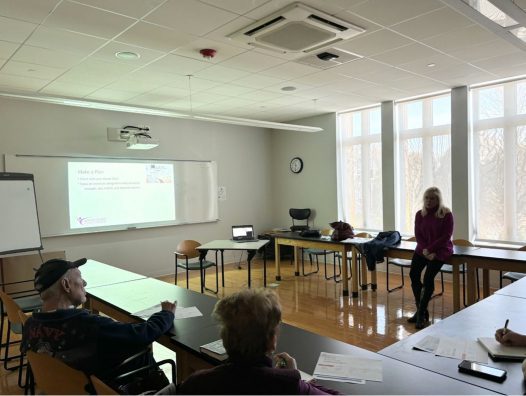By Madison Butkus
Hometown Weekly Reporter
With the frigid winter weather still upon us, many individuals fall into what is known as the ‘winter blues.’ While different from depression, this can still cause many to neglect their health and fall harder into this seasonal feeling. To lend a helping hand to seniors about this topic, Healthcare Advocate Lynn Croft presented on “Coming Out of the Winter Blues” at the Needham Council on Aging (COA).
Seniors filed into The Center at the Heights (CATH), some bringing along some notebooks and pens, to learn all about how to better come out of these winter blues. Throughout Croft’s presentation, COA members were able to see and discuss the five main areas of mental health, diet, sleep, exercise, and how to keep on goal. The overall objective of this event was for seniors to walk away with a better understanding of how to lead a more enriched life, especially during the dark and cold winter months.
At every seat, Croft placed two helpful handouts for seniors to refer to: A Physical Wellness Checklist (PWC) and a Sleep Journal. The PWC was provided by the National Institutes of Health in which it depicted some helpful tips for improving one’s physical health. These tips included getting active, maintaining muscle tone, eating a healthy diet, being mindful of one’s metabolism, building healthy habits, and finding a healthy weight. The Sleep Journal was provided by Today.com and allows seniors to record their sleeping habits over a period of a week to find out what their individual secret is to a good night’s sleep.
At the beginning of Croft’s presentation, she went through the differences between winter blues and seasonal affective disorder (SAD). While some symptoms can be the same for both, Croft pointed out that there are two main differences between each. For one, winter blues are usually linked to something specific such as stressful holidays, reminders of absent loved ones, or even the lack of sunlight throughout the winter. On the other hand, SAD is feeling depressed most of the day, nearly every day with no exact link all the time. The second major difference is that winter blues can be easy to come out of / does not require any medical treatment, whereas SAD will require some sort of medical treatment whether that be light therapy or cognitive behavioral therapy. Croft informed all in attendance that it is best to consult with their doctor for an exact diagnosis.
As Croft’s presentation went on, COA members learned about the importance of doing things they enjoy, making sure they have a support system around them, how foods impact aging, how sitting impacts aging, how to improve their self talk, and more. With each topic of discussion, Croft made sure to give seniors examples that they could all relate to, like participating in activities around the CATH to stay active and create friendships, which foods to try to stay away from and how to relax before bed time.
Seniors were welcome to take notes throughout the discussion and ask any questions they may have had. As they each walked out of this event, it was easy to tell that many seniors learned some new things that they were eager to try out in order to better their health and mindset through these winter blues.






















